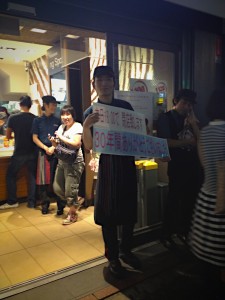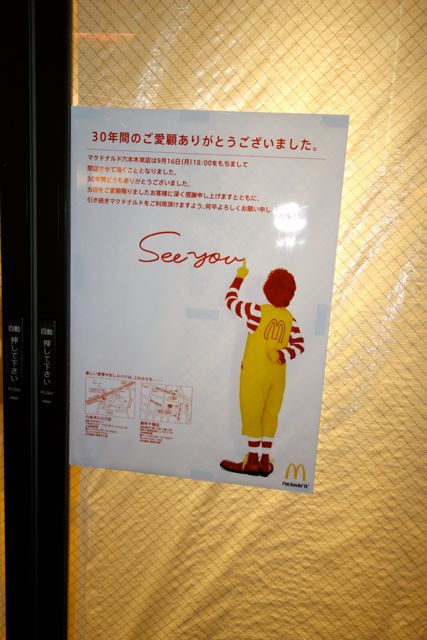Today, September 16th at 18:00 hours, the McDonald’s East Roppongi shop (マックドナルド六本木東店) closed after 30 glorious years of serving the hungry masses. It was the second most well-known landmark meeting space in Roppongi, the gaijin Kabukicho formerly known as “high-touch town”. In the days when ROA Building was a hotbed of cool clubs and the area was thriving, the McDonald’s was only surpassed by the pink Almond Cafe at the corner of Roppongi Crossing as a meeting spot that everyone knew. Even in recent years, it served as the last refuge for those who had missed the last train, had clubbed themselves out for the night, or people looking for cheap eats in the middle of the night.

All the reasons for its demise are not known. Rumors of the closing had been circulating for weeks, but then today it actually happened. There is still eastern Japan’s largest McDonald’s alive in well in Roppongi Hills, if you feel like walking a bit for your Big Mac. If you are craving fast food, near Don Quixote, there is still a Wendy’s close by, tastefully decorated and brightly lit.
Yet, the question remains: what killed the Roppongi McDonald’s?
It doesn’t appear to be the work of a single culprit.

One of the reasons for the collapse is certainly the intense police crackdown on dancing after midnight in the Roppongi area. The draw of old Roppongi (the area between over-opulent Roppongi Hills and super-chic Roppongi Midtown) has been a few vibrant dance clubs in the area. With those gone, the foot traffic has seriously slowed down. A Roppongi where you can’t dance away isn’t worth a damn to many people.
It’s not only Roppongi that has been footbound (as opposed to “Footloose.”)
If you’re thinking about dancing the night away to some great trance music, or even old-fashioned rock, you may have a tough time finding a venue in Japan these days. In fact, you may end up waltzing away hours inside a police station, pissing into a cup after being rounded up in a raid. It’s not just Tokyo, in Kansai as well, “The War on Dance” is raging on. *
Last September 2nd, at 3:40 am, members of the Kanto Rengo gang burst into the VIP room in Roppongi’s Club Flower and clubbed a man to death in front of 300 people. Since then, the police have been making regular raids on the nightclubs, discos, and live houses that make night life in this city vibrant and fun. The intensity of the raids have gone up, but in fact, they are simply a continuation of what began in Osaka in 2012.
Ostensibly, the clubs are being raided for violating Japan’s archaic Adult Entertainment Laws which forbid dancing after midnight. The police are simply enforcing the laws. That’s the official party line.
But anyone who has lived in Japan for several years knows that wasn’t always the case. The laws existed on the book, gathering dust, but were rarely enforced
So why now is there a “War on Dance?” Is it a part of the “War on Drugs”?
Who do we blame? Do we blame the police? Do we blame the Kanto Rengo for killing a man after dancing hours, thus reminding everyone that the Adult Entertainment Laws (AEL) were being ignored?
The answer is complicated.
Let’s start with the obvious answer: it really is against the law to dance after midnight in most venues in Japan. This is well explained in the book Odotte wa Ikenai Kuni, Nihon (Japan: The Land Where You Can’t Dance) .
The Adult Entertainment Laws originally were revised after WWII to clamp down on the infamous “Dance Halls” which were thinly disguised venues of prostitution. Several decades later “Dance Halls” have been replaced by clubs, discos, and bars with dance floors; they are not proxy brothels. The places people dance have changed, as have the customers; the laws have not.
I don’t think there is anyone who would argue that dancing itself is dangerous or unhealthy. Dance is part of the educational curriculum in Japan. Some forms of dance are considered cultural treasures. So why would dancing at a club after midnight miraculously transform what is a healthy form of entertainment into a threat to the public welfare? Do dancers transform into rampaging werewolves as the clock strikes midnight? There is no logical answer.
One unofficial answer from the police is this: “It’s much easier to raid a dance club on violations of the AEL than it is to get a warrant for a drug search. Dance clubs are hotbeds of drug activity.”
Maybe, that’s partially true. At some dance parties, there will be people using ecstasy (MDMA). There will also be people getting so drunk that they get alcohol poisoning. There will also be people just dancing. Should the rest of us be banned from the dance floor because of a few reckless people?
The hardline enforcement of forgotten laws may make the police look good. It is a nuisance for everyone else. It hurts the business of legitimate clubs. It discourages people from staying out late, making nightlife boring. If there’s no place to dance after midnight, than many people will go home. It’s bad for tourism as well. “Tokyo: The City That Always Sleeps Before Midnight”—try attracting people to Japan with that slogan. Ultimately, it hurts the economy and encourages corruption. Clubs relying on late-night traffic will go out of business. Clubs that want to stay in business will pay bribes and protection money to avoid the raids.
That brings us to another reason for the “War On Dance”. It stems a bit from the Organized Crime Exclusionary Ordinances that went nationwide on October 1st, 2011. In the old days, the clubs paid off the local yakuza. In return, they often got advance notice when a token raid was coming. The yaks provided muscle when customers got out of line and kept local street crime down. No muggings, purse snatching, or theft allowed. The smart clubs avoided getting shut down, kept pushers off the premises, and people felt safe going to them.
The police knew the clubs were operating way past legal hours, but looked the other way. The enforcement was so sparse that late-night dancing existed in a comfortable grey zone.
But when doing business with the yakuza became a crime in itself, the clubs stopped paying them. The non-designated organized crime groups, like Kanto Rengo, cut in on the dance. They became the unofficial security guards. They soon found the clubs lucrative venues to peddle drugs and in some of the high end clubs, prostitutes as well.
Dance Hall days were here again.
The Flower killing made it clear that the “new yakuza” were now running the nightlife. The investigative journalist Atsushi Mizoguchi coined a term for these outlaws: hangure (半グレ). It comes from the Japanese word for “half” and 愚連隊 (gurentai). After the war, Gurentai were the undisciplined youth gangs who preyed on the general population, engaging in theft, robbery, and violent crimes. The “half” in the term is also an acknowledgement that these new groups are “half” yakuza as well. Many of them are backed by yakuza or ex-yakuza that can no longer operate in the open, and have no code of honor to burden them.
(Maybe there was a possibility that Ronald McDonald was actually a former yakuza–or maybe even a current member. How many fingers does he have? Why is he always wearing gloves? And what about his strange friendship with the Hamburglar? Perhaps, the McDonald’s closing is actually an enforcement of the organized crime exclusionary ordinances gone slightly awry?)
A few weeks after the Club Flower murder, the National Police Agency reportedly issued a directive to all police departments to strictly enforce the Adult Entertainment Laws. The directive was meant hurt the hangure and deflect criticism of lax enforcement. And the cops have been doing their jobs.
The Japanese police are no longer comfortable with grey zones; everything has to be black and white. Grey is the enemy. The dance clubs closings are the casualties of a badly run war. Coincidentally, hangure, can also be read as “half-grey.” It’s the color of “illegal.”
Not everyone is taking this haphazard enforcement lying down. The Let’s Dance Committee, headed by a lawyer and run by a group of volunteers is lobbying for changes in the law that will protect Japan’s “dance culture.” They have already collected nearly 160,000 signatures for a petition to the government.
If you want to join the tango, check it out http://www.letsdance.jp.
But in the meantime, until someone brings the laws up to date, the War on Dance will keep on moving to the music of the National Police Agency marching band. And Roppongi will move closer towards becoming a ghost town.
*portions of this article were previously published in The Japan Times
The war on dance clubs goes back to the Taisho Era with the laws restricting dance halls. There is good coverage of this in the book Blue Nippon by E. Taylor Atkins.
https://www.dukeupress.edu/Blue-Nippon/?viewby=title
With the Tokyo Olympics coming up expect more tightening of restrictions. It happened before the 1964 Olympics with banning all night coffee shops etc.
Dan Kanemitsu has been writing on potential impacts on the doujinshi and manga market:
http://dankanemitsu.wordpress.com/2013/09/10/fear-and-loathing-in-the-bold-new-olympic-era/
Great material! Thank you. I’ll look at that.